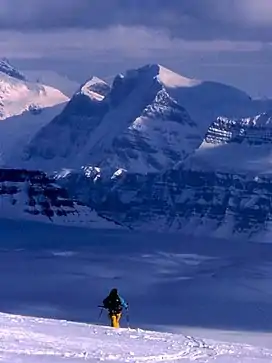Oppy Mountain
Oppy Mountain is located on the border of Alberta and British Columbia, North of the head of Lyell Creek. It was named in 1918 by interprovincial boundary surveyors after Oppy, a village in France. During World War I. the village had been captured by Germany in 1914. In May 1917, many Canadian soldiers were killed in the area during the Third Battle of the Scarpe.[5]
| Oppy Mountain | |
|---|---|
 Oppy Mountain from the Columbia Icefield | |
| Highest point | |
| Elevation | 3,335 m (10,942 ft)[1][2] |
| Prominence | 311 m (1,020 ft)[3] |
| Parent peak | Mount Alexandra (3401 m)[3] |
| Listing | |
| Coordinates | 51°58′24″N 117°08′56″W[4] |
| Geography | |
 Oppy Mountain Location in Alberta and British Columbia  Oppy Mountain Oppy Mountain (British Columbia) | |
| Country | Canada |
| Provinces | Alberta and British Columbia |
| Protected area | Banff National Park |
| Parent range | Park Ranges |
| Topo map | NTS 82N14 Rostrum Peak[4] |
| Climbing | |
| First ascent | 1947 J.C. Oberlin, R. Davis, D.M. Woods[3] |
Geology
Oppy Mountain is composed of sedimentary rock laid down from the Precambrian to Jurassic periods.[6] Formed in shallow seas, this sedimentary rock was pushed east and over the top of younger rock during the Laramide orogeny.[7]
Climate
Based on the Köppen climate classification, Oppy Mountain is located in a subarctic climate with cold, snowy winters, and mild summers.[8] Temperatures can drop below -20 °C with wind chill factors below -30 °C. Weather conditions during summer months are optimum for climbing.
See also
References
- "Oppy Mountain". cdnrockiesdatabases.ca. Retrieved 2021-09-11.
- "Topographic map of Oppy Mountain". opentopomap.org. Retrieved 2021-09-11.
- "Oppy Mountain". Bivouac.com. Retrieved 2021-09-11.
- "Oppy Mountain (Alberta)". Geographical Names Data Base. Natural Resources Canada. Retrieved 2021-09-11.
- "Oppy Mountain". BC Geographical Names. Retrieved 2021-09-11.
- Belyea, Helen R. (1960). The Story of the Mountains in Banff National Park (PDF). parkscanadahistory.com (Report). Ottawa: Geological Survey of Canada. Archived (PDF) from the original on 2015-10-02. Retrieved 2019-09-13.
- Gadd, Ben (2008). Geology of the Rocky Mountains and Columbias.
- Peel, M. C.; Finlayson, B. L. & McMahon, T. A. (2007). "Updated world map of the Köppen−Geiger climate classification". Hydrol. Earth Syst. Sci. 11: 1633–1644. ISSN 1027-5606.